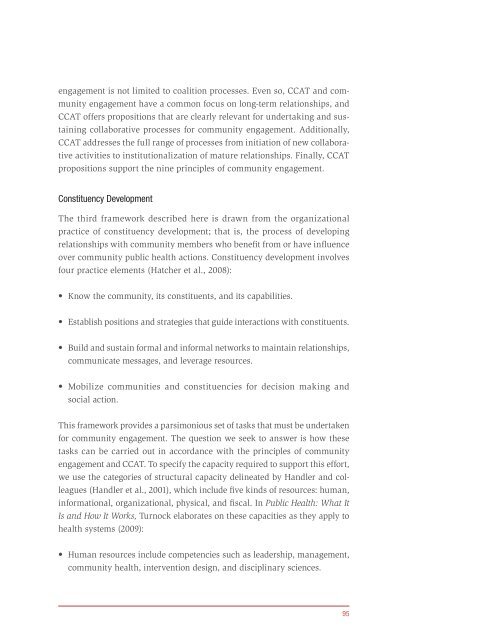Principles of Community Engagement (Second Edition)
Principles of Community Engagement (Second Edition)
Principles of Community Engagement (Second Edition)
Create successful ePaper yourself
Turn your PDF publications into a flip-book with our unique Google optimized e-Paper software.
engagement is not limited to coalition processes. Even so, CCAT and com-<br />
munity engagement have a common focus on long-term relationships, and<br />
CCAT <strong>of</strong>fers propositions that are clearly relevant for undertaking and sustaining<br />
collaborative processes for community engagement. Additionally,<br />
CCAT addresses the full range <strong>of</strong> processes from initiation <strong>of</strong> new collaborative<br />
activities to institutionalization <strong>of</strong> mature relationships. Finally, CCAT<br />
propositions support the nine principles <strong>of</strong> community engagement.<br />
Constituency Development<br />
The third framework described here is drawn from the organizational<br />
practice <strong>of</strong> constituency development; that is, the process <strong>of</strong> developing<br />
relationships with community members who benefit from or have influence<br />
over community public health actions. Constituency development involves<br />
four practice elements (Hatcher et al., 2008):<br />
• Know the community, its constituents, and its capabilities.<br />
• Establish positions and strategies that guide interactions with constituents.<br />
• Build and sustain formal and informal networks to maintain relationships,<br />
communicate messages, and leverage resources.<br />
• Mobilize communities and constituencies for decision making and<br />
social action.<br />
This framework provides a parsimonious set <strong>of</strong> tasks that must be undertaken<br />
for community engagement. The question we seek to answer is how these<br />
tasks can be carried out in accordance with the principles <strong>of</strong> community<br />
engagement and CCAT. To specify the capacity required to support this effort,<br />
we use the categories <strong>of</strong> structural capacity delineated by Handler and colleagues<br />
(Handler et al., 2001), which include five kinds <strong>of</strong> resources: human,<br />
informational, organizational, physical, and fiscal. In Public Health: What It<br />
Is and How It Works, Turnock elaborates on these capacities as they apply to<br />
health systems (2009):<br />
• Human resources include competencies such as leadership, management,<br />
community health, intervention design, and disciplinary sciences.<br />
95

















